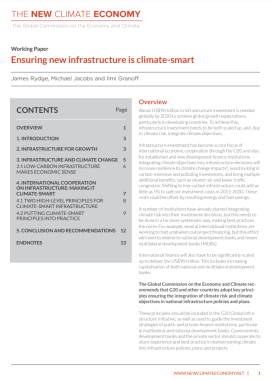
This paper identifies different potential pathways to decarbonization of Indian Railways by 2030 and examines their cost-effectiveness and feasibility.
Downloads
738.31 KB
This website has been archived. Visit wri.org to learn more about continuing work under World Resources Institute’s Climate, Economics and Finance Programme.

This paper identifies different potential pathways to decarbonization of Indian Railways by 2030 and examines their cost-effectiveness and feasibility.
738.31 KB









Better, smarter urban growth could be an economic opportunity for India worth up to 6% of GDP by 2050, according to the latest research from the New Climate Economy.
India should work with other G20 countries to accelerate the transformation to a low-carbon, resilient economy, writes Naina Lal Kidwai in Hindustan Times.
China and India, the world's two most populous nations, have much to learn from each other on urbanization, energy, and finance, writes Global Commissioner Naina Lal Kidwai.
India has a unique opportunity to prepare and build for a future that is low-carbon and climate-resilient, writes Naina Lal Kidwai in Business Today.
Home to more than a billion people, these countries are charting a dynamic path towards low-carbon wealth. To stay the course, they'll need to confront three issues: inclusive development, rapidly-expanding cities and economy-wide measures for reducing carbon emissions, writes Priyanka Mohanty.
As the two largest emerging economies, China and India are already at the forefront of economic growth and development. Now, they are becoming global leaders by taking ambitious steps to combat climate change, writes Naina Lal Kidwai.